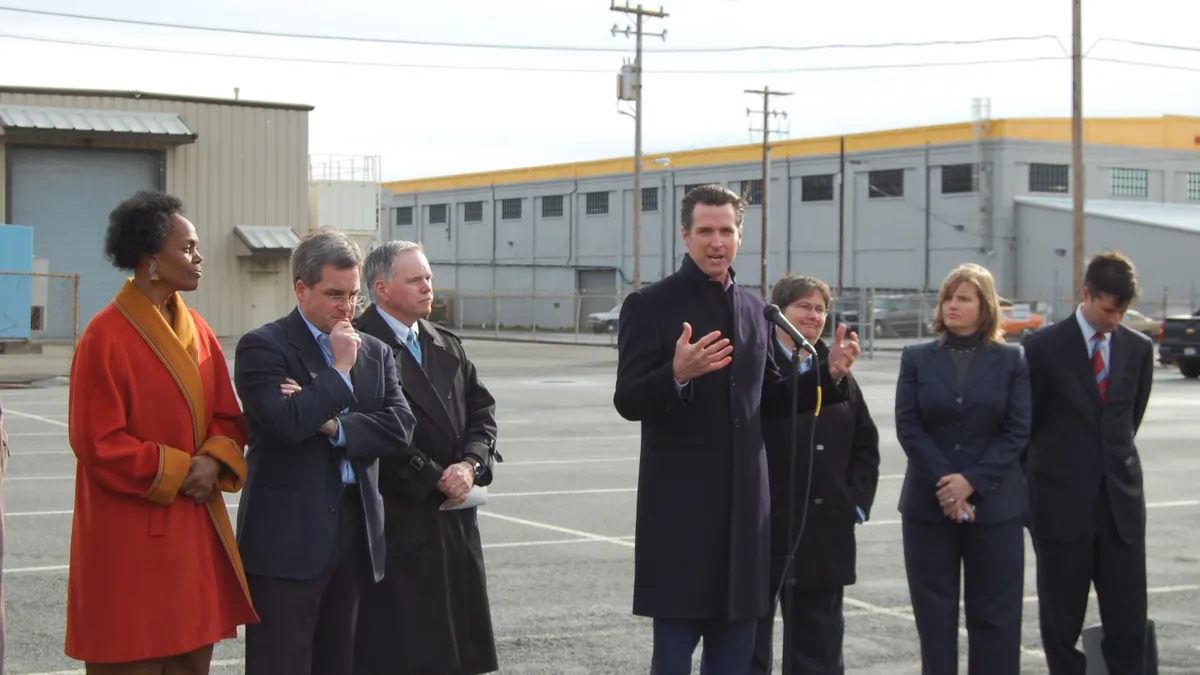UPDATE: Dec. 17, 2019: PG&E amended its agreement with the committee of wildfire victims to move forward even without Gov. Newsom's approval.
Dive Brief:
-
Pacific Gas & Electric (PG&E) is moving ahead with a hearing today on its proposed settlement with wildfire victims despite California Gov. Gavin Newsom’s assertion that the company’s reorganization plan does not comply with state legislation.
-
The governor’s office penned a letter on Friday to PG&E Corp. President and CEO Bill Johnson, saying the plan does not comply with Assembly Bill 1054, which state lawmakers passed in July to help utilities pay for wildfire damages. But PG&E announced Tuesday that it has amended its agreement with a committee of wildfire victims to move the settlement forward with or without Newsom’s approval.
- Newsom's intervention and responses from state legislators signal that PG&E is far from reaching a consensus that will pull it out of bankruptcy. If the utility does not introduce changes to its current plan, "I would definitely do whatever I could to prevent the [state regulators] from moving forward" with it, Sen. Jerry Hill, D, told Utility Dive in an interview.
Dive Insight:
PG&E’s restructuring proposal includes a $13.5 billion payout to victims of the Northern California wildfires in 2015, 2017 and 2018, and an $11 billion settlement with a group of insurance companies. The utility needs to exit bankruptcy by June 30 in order to access California’s new wildfire insurance fund. And in order to comply with the legislation, its eventual reorganization plan would need to resolve its wildfire liabilities and receive the greenlight from the CPUC. The commission is currently reviewing the reorganization proposal to determine whether it aligns with California’s climate goals, is cost-neutral to ratepayers, and creates a reorganized governance structure that will address the utility’s troubled record on safety.
"The CPUC's review of the plan of reorganization is not a rubber stamp — it is a critical component of AB 1054," Newsom said in the letter, shared by NPR.
In his view, however, the utility's current proposal falls short of these standards, in part because the resulting company "will not be positioned to provide safe, reliable and affordable electric service." One of Newsom's concerns about the plan is its reliance on short-term bridge financing, and the fact that it leaves the company without much wiggle room to cope with "future financial and operational headwinds." His office will be in touch with PG&E to provide his opinion on specific portions of the plan, he said.
PG&E believes its reorganization plan meets the requirements of AB 1054 and is the best course forward for all stakeholders, utility spokesman Jeff Smith said in an email.
"We've welcomed feedback from all stakeholders throughout these proceedings and will continue to work diligently in the coming days to resolve any issues," he added.
Meanwhile, state lawmakers have been equally critical of the utility. California Sen. Jerry Hill told Utility Dive he was pleased to see Newsom take an aggressive position on PG&E's proposal.
"It really indicates a sentiment that I believe is universal within the legislature, which is the company cannot move forward out of bankruptcy unless there are major reforms, structural changes and cultural changes to the organization, where safety becomes a priority," he added.
A key issue with PG&E's plan, in Hill's view, is the board's focus on quick profits and a bankruptcy exit strategy rather than safety — and the legislature will do whatever it can to prevent the continuation of the same company culture, he said. He noted that a competing reorganization proposal advanced by PG&E's bondholders is no different in that respect.
"I certainly don't care who prevails in the bankruptcy, other than that the structure and the culture and the management of the company is changed to support a safety priority — and we've not seen that in PG&E for 20 years," he said.
Another possible consequence of Newsom's letter is a renewed interest in the prospect of municipalizing PG&E — a suggestion that was pitched by the mayor of San Jose, but rejected by the utility.
"I think that's a much more viable alternative today than it was a couple of weeks ago. To me, the question is can they create the financing necessary, and how would they deal with future liabilities?" Hill said.
"Of course PG&E is going to claim its plan is great and complies with the law, but only a sucker would believe them at this point," California Sen. Bill Dodd, D, said in a statement.
"It's their standard operating procedure to say one thing and do another. As coauthor of Assembly Bill 1054, I can tell you we intended and must demand a better outcome for our ratepayers and communities," he added.
PG&E could face a hostile political environment going forward, Josiah Neeley, senior fellow of energy policy at the R Street Institute, told Utility Dive.
"If you are a utility, having the governor against you in general is not a great sign because there are dozens of different ways that he can make your life difficult — either directly or through the various agencies," he said.
Newsom's letter indicates the potential for political micromanagement or interference in PG&E's ability to get out of bankruptcy, according to Neeley — a factor that could cause concern for the financial community. The company's share price dropped from $11.26 on Friday to $8.89 when markets reopened on Monday, before closing at $9.67 that same day.
Ratepayer advocacy group The Utility Reform Network (TURN) also urged Newsom on Thursday to reject PG&E's current proposal. The CPUC should instead review both PG&E's and the bondholders' competing plan to determine whether either complies with AB 1054's requirement that ratepayers not bear increased costs, TURN Executive Director Mark Toney wrote in a letter to the governor.
"TURN believes that it is the interest of ratepayers and wildfire claimants to have the relative merits of competing plans considered by the bankruptcy court and the CPUC," Toney said.















